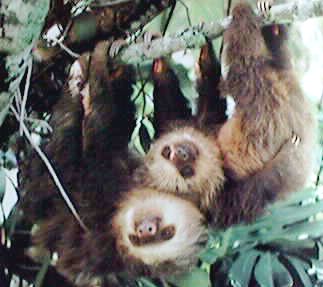Megalonychidae
two-toed sloths
This family contains 2 species placed in a single genus, Choloepus. Two-toed sloths are found in Central America, throughout northern South America and in the Amazon basin.
Two toed sloths are medium-sized animals, with a body slightly more than half a meter in length and weight up to around 9 kg. They are covered with long, usually pale gray-brown fur (paler on the head) that takes on a greenish hue due to symbiotic algae living on the hairs. Under the coarse outer fur, the pelage grades into a layer of finer, shorter underfur. External ears are much reduced in size. The forelimbs and hindlimbs are long, with the forelimbs somewhat longer than the hindlimbs (but the difference is not as extreme as it is in three-toed sloths, Bradypodidae. The forelimbs end in two large, curved claws; these are attached to digits that are enclosed in a web of skin (syndactylous). The hindlimbs have three claws and are also syndactylous. The tail is small or absent.
The skulls of these sloths are relatively short. The rostrum is distinctly convex in profile. True tympanic bullae are lacking. There is, however, an ectotympanic, and the pterygoids and alisphenoids are swollen, forming a sort of inflated bullae. The mandible has a large coronoid process, and the condyloid process lies in the same plane as the toothrow. The zygomatic arch is incomplete, the jugal ending in flared dorsal and ventral processes. The premaxilla is small.Megalonychids have 5/4-5 cheek teeth. Incisors and canines are absent, but the anterior cheek teeth are enlarged, triangular in cross section, and canine-like. They are separated from the rest of the cheek teeth by a diastema. The anterior surface of the lower canine-like tooth meets the posterior surface of the upper, wearing against each other and continually sharpening their edges. These sloths feed mainly on leaves, but also include some fruits, buds, and even small vertebrates in their diets. Like three-toed sloths, they move in a very slow and deliberate fashion (but megalonychids are faster than bradypodids). Most of their lives are spent high up in trees, although they, like bradypodids, come to the ground to defecate. They swim well. Two-toed sloths are capable of vigorous self defense, using their foreclaws to slash a predator and biting with their enlarged, canine-like cheek teeth.
Two toed sloths are perhaps more heterothermic than any other mammal. Their body temperatures fluctuate from as low as 24 degrees C to as high as 33 degrees C. Unlike three-toed sloths, however, they do not thermoregulate by basking.
Megalonychids first appear in the fossil record in the Early Miocene. They were found in North America in the Pleistocene, becoming extinct as recently as 11,000 years BP (giant ground sloths).
HOME
HerbWeb
Sloth hotlinks
Three-toed sloths
The Animal Rights FAQ01 : 02 : 03 : 04 : 05 : 06 : 07 : 08 : 09 : 10 : 11 : 12 : 13 : 14 : 15 : 16
S L O T H S . O R G
T H E C O U N T D O W N H A S B E G U N
